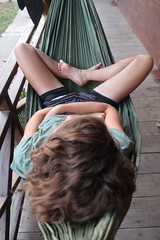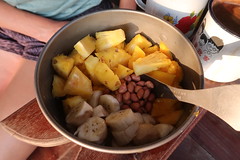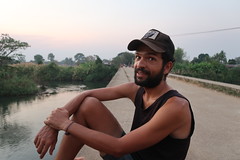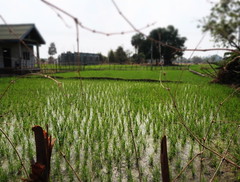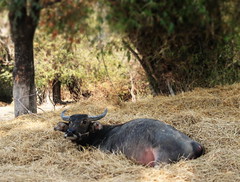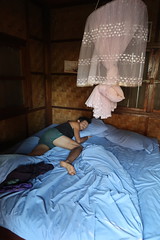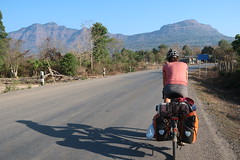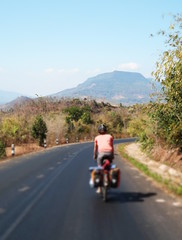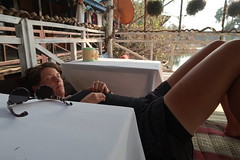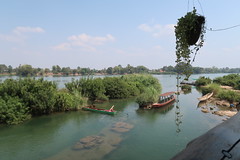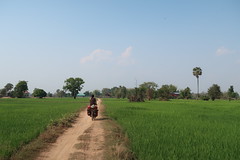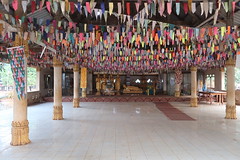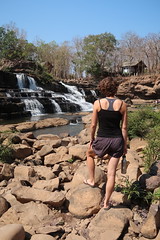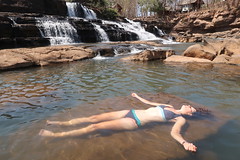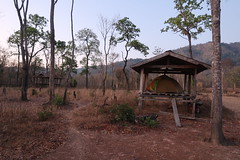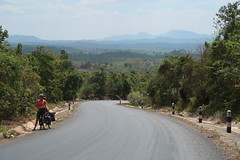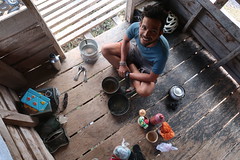Over the last 8 days we had covered 700km. It was the largest distance we had pedaled in the shortest number of days over the whole trip. Although the roads had been entirely flat, the last few had been in the company of a ferocious headwind. Our bodies, brains and bums were in need of a good rest.
Having spent our remaining Cambodian Riel on some overpriced fried rice, with some trepidation we headed for the Laos border. We weren’t 100% sure that this crossing was still offering a visa on arrival. For some reason, over the last few weeks, Laos had slowly been retracting the availability of these visas. Most of the border crossings where the rules were changing were listed online, but just to keep you on your toes, sometimes an unlisted border crossing also turned people away. People then had to retrace their steps to Hanoi, Bangkok or Phnom Penh and apply for a visa at the Laos embassy instead and then race back.
Thankfully, we were given a visa and crossed into Laos (again) with just the usual bartering of bribes. Asking for a receipt however usually helps get rid of those.
Having said farewell to it close to Kratie back in Cambodia, we were again beside the Mekong and in the region of Si Phan Don, a group of (supposedly 4000) islands in the Mekong River. Some of the islands in the Mekong are little more than sand banks, home only to a few palm trees, which get submerged in the monsoon season. Whereas others are car-free islands scattered with houses and a few are tourist hotspots filled with backpackers on the banana pancake trail.
We were heading for Don Det, which is filed under the latter category; its plentiful bungalows suiting our budget. Us, our bikes and bags, plus the bikes and bags and bodies of three other cyclists piled into a rickety long boat for the (thankfully) short crossing. It was simply best to enjoy the view and tranquility of the river, rather than to question the structural integrity of the boat.
In the era of Booking.com and Agoda, it was harder than expected to find a place to stay, but our search was scenic and took us down almost the entire length of the island. Eventually we came across a newly built terrace of bungalows that had not yet made its way online and we settled ourselves into the hammock for a few days of doing very little.
Given that this was the cleanest room we had seen in months, we soon set about turning it into a multi-purpose apartment. The bathroom became a barber shop and laundry and the bedroom a water filtering station, and much to the ants’ delight, a kitchen.
It was the perfect place to relax. The most energetic thing you could do was to cycle around the island, which was barely 3.5km long. Days passed swinging in the hammock, reading, napping, and watching the sun set with a Lao mojito in hand. We could have easily stayed much longer and become permanently hammock shaped. Although the island was overrun with tourists, and as we had found out when we first arrived, with much of the accommodation full, it was still incredibly chilled out. I guess everyone was there with the same intention, although some aimed to reach their relaxed state through hammock swinging and others with whiskey and weed.
Our tour through South East Asia was definitely the most densely touristy stretch of our trip. Even by bike it was hard to remove ourselves from the well-trodden path. Perhaps if we had mountain bikes and were carrying less stuff we would have been able to take some less travelled, much sandier paths, but for this trip we were restricted to the better used routes. At times we definitely missed the remoteness of Central Asia, but not showering for a week in South East Asia doesn’t work so well. After one day of cycling here, we were generally filthier than after 10 days of cycling in Kyrgyzstan. We accepted the situation and ordered another iced coffee. The relative civilization had its perks.
On the morning we were due to leave Sarah still felt tired, but rather than stay an extra day we compromised by having a lazy morning before pushing on in the afternoon. As was increasingly standard for us in South Asia, we blamed the tiredness on a bad night’s sleep. Potentially not the best of ideas.
The next days’ cycles were increasingly tiresome. The plan was to island hop north to Pakse, rather than following the bigger road on the mainland. We took ferry boats of varying sizes between the islands with varying densities of traffic and wildly differing road surfaces. Naturally the smaller ferries and islands, and with the sandier roads, were the ones which were more fun to cycle. Camping was hard everywhere, either we had a restless night camping too close to peoples farms and houses, or lacking any alternatives we were forced to stay in rooms in guesthouses which were so filthy that we didn’t want to touch the walls let alone the bed sheets. We’re fine with basic, but sleeping in other people’s filth is just gross.
As we went north, the traffic increased to a degree that although not necessarily busy, it still meant we could no longer ride side-by-side and have a chat. Sarah was feeling increasingly lethargic and we just weren’t feeling it. It was hot, with few places to stop for shade or refreshment. We blamed it on what we defined as South East Asia Syndrome – the effects of too many days of excessive heat, dust, bugs and bad sleep.
It was some respite to know that we weren’t alone. We were in touch with a few cyclists we had met along the way. Given how most of us cycle to the same tune of seasons, now at the beginning of the year, there were many of us here in South East Asia. Most cyclists we knew, we diagnosed to be suffering from SEA Syndrome, the causes and symptoms numerous but similar. On top of this, we realised that all the tales we had heard of couples breaking up whilst making long distance bike trips, 99% broke up whilst in South East Asia. Just sayin’ – it’s real.
Eventually we reached Pakse, the biggest city we expected to pass on this trip through Laos. In hindsight we should have taken the afternoon off in Pakse, even though it was just two days after having had three days off, but we didn’t. After searching for and failing to find oats, we pedaled up the hill out of a Pakse, the first hill we had seen in about a month, at a pace even a snail would question. Our legs and body simply did seem to want to be cycling.
Hot, tired, sweaty and dusty we called it a day. Given that we were still on a relatively big road, as we had many times in Cambodia and Thailand, we asked in a temple if we could put our tent somewhere quiet to sleep for the night. We’d hung a mosquito net inside our tent to make it more airy, but it was still too hot, and the overly inquisitive local kids coming with torches after dark, did not help us get a good rest.
An explanation for the ongoing lethargy and lack of appetite was given the next day with an urgent trip to the toilet. We half hitched, half cycled towards Tad-lo. We hadn’t originally planned on going there, but according to our maps it had a big concentration of guesthouses and it was only 40km from where we had been forced to stop. Turns out it was another stop on the backpacker banana pancake trail.
And it was just ideal. There were waterfalls for Pedro to go and explore and plenty of rooms available at such cheap prices that I could rest for as long as I needed, and we wouldn’t be tempted to leave prematurely to save a few Kip. When my stomach was feeling stronger there was even a potato rosti on the menu at a neighboring French-owned guesthouse. When was the last time we had had potato?!
We weren’t sure of the source of Sarah’s woes. Pedro was fine, only suffering from sympathy sleepiness warranting a few afternoon naps. It was highly likely that it was just traveller’s diarrhea, but ironically it could have also been caused by the doxycycline that we were taken as anti-malarial medication. Oddly, as we had entered the region which was defined as having malarial risk, we had barely been troubled by mosquitoes. We decided to take the risk and to stop taking the drugs, and to rely instead on trying to minimize getting bitten in the first place.
After three nights, an appetite returned, and after a morning spent staring at maps, we plotted our way north following a route that we thought should exist in some form or other.
That first night post Tad-lo we were super happy to find a place to camp. Nights of camping were becoming increasingly rare in South East Asia, let alone in a spot which was actually quiet and scenic and didn’t involve hiding in bushes. We missed our tent and it’s cosy interior. As we pulled off the road, we were aware of a fire burning in the forest on the opposite hillside. Not the most comforting of scenarios to set your tent up in sight of, but there would be scrub land and a wide road between it and our tent, and the wind was blowing in the wrong direction to send it towards us anyways.
Throughout Laos there are thousands of bamboo shelters to provide protection from the sun and a place for locals to rest as they work the fields. During the night they are empty and the perfect temporary home for two cyclists. As we sat inside ours, half inside the tent hiding from the mosquitos, we became aware of the clanging bells around the necks of the cows that had joined us in the field. An innocuous sound, until you try to sleep at which point it penetrates your brain and cannot be ignored.
As we climbed into the tent and attempted to try and sleep we saw flashlights on the canvas. It turned out to just be men from a nearby village who, from what we could ascertain had come in the dark to inspect the soil in the field. It didn’t make sense to us either. After a little while they left, but even though they had been perfectly friendly we were left a little on edge. We had a restless night ahead of us.
The next day was due to be hilly, and steep. We stopped for a snack at the bottom of the first climb to bolster energy levels. Hills with a 12% gradient however, are not forgiving, especially when trying to cycle a fully loaded bike up them and definitely not when lacking a good sleep. It was soon evident that bananas were not sufficient to make up the calorie deficit of not having eaten properly due to Sarah’s troubled intestines over the last few days. Even pushing the bike was too much.
The batteries were empty. Petrol tank depleted. Energy levels zero. Motivation absent.
Pedro rode his bike up every hill and ran back down half way to push up my bike as I listlessly wove my way to the top. At each top we could see the road rolling onwards, weaving downhill and back up again losing and gaining 150m over just 2km. The sight was enough to bring me to tears. We had cycled countless roads like this before, but today I just could not.
Somehow we made it to TaOy, in time for a much needed albeit very late lunch. We both knew we were in need of a change. Over our rice and fried greens we discussed our options. We were missing greenery and after having moved so slowly over the last two weeks through rest days and sick days, on top of a few too many sleepless nights our brains needed a reset.
The Lalay border with Vietnam was just over 50km away. In the space of an hour we changed our plans from cycling in Laos for another week, through part of the Thakek loop, to crossing into Vietnam the very next day. We called it a night, found a guesthouse and slept, happy with our decision for change.
The change came even before we reached the border. As is often the case in border regions, the area was remote with only a few villages scattered here and there. The border had only recently been open to foreigners and it was clear that the crossing was not well used even by local people. Why would it be?
Our surroundings were the greenest they had been since we had cycled through the jungle in the west of Thailand. The reason for the greenery was soon demonstrated as we found shelter to cook our lunch and took out our raincoats for the first time since… the south of China? Although we knew of the severe impact of the American War (as it’s called in Vietnam) on Laos, we hadn’t seen it before with our own eyes. Yet as we cycled east, craters scarred the landscape and we began to see painted ammunition and bombs standing vertically outside of schools and public buildings, as permanent reminders of the dangers which still mutilate their soil and souls.
As we cycled through these villages, for the first time rather than run towards us, children would run away from us – through a field or into their homes. The usual cries of sabaidee were replaced with silence and stares of disbelief. For the first time since the Xinjiang province in China, we watched jaws physically drop. We got the feeling that they didn’t see many foreigners ‘round here, let along foreigners carrying their lives on a bicycle.
After a while, it was a little disconcerting. Especially given that talk of Covid-19 was bubbling globally. We had heard of cyclists in Vietnam having some troubles with locals as a result – being turned away from shops, restaurants and guesthouses for fear that they would bring the virus with them. We wondered if the fear was spreading to Laos and if this was the reason why the children were running away from us.
Eventually, as dusk was approaching we reached the border. It was clear they weren’t used to dealing with e-visas, and with temperature checks and extra careful passport inspections it took longer than usual to cross the border. By the time we were in Vietnam it was dark – never the best way to enter a new country. With worn out brake pads, we cautiously rolled down the 7km of switchbacks in the drizzle to the first town.
Accepting that we weren’t going to find a campspot in the dark, we asked if we could put our tent in a patch of grass by a small gas station. Much to our delight and relief, the owners greeted us with a smile and upgraded our hopes of camping on a patch of grass and opened up a small unused garage for us to sleep in and be sheltered from the rain. They filled our bottles with drinking water and with the help of Google Translate, wished us a “goodnight”
Vietnam was off to a good start.







